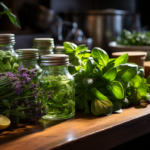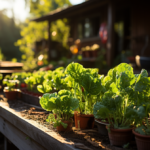Table of Contents
Transform Your Kitchen with Fresh Produce: Follow These Simple Steps to Build Your Own Raised Bed Garden
Have you ever considered growing your own herbs and vegetables for cooking in your kitchen? A DIY raised bed garden is a cost-effective solution that not only provides you with fresh produce but also enhances the aesthetics of your kitchen. In this article, we will take you through the step-by-step process of assembling a raised bed garden in your home without breaking the bank. The best part is, you don’t have to be a gardening expert to achieve great results! With a little effort and some basic tools, you can have a beautiful and functional garden that you can enjoy all year round. Let’s get started!
Benefits of a Raised Bed Garden
Have you considered starting a garden in your kitchen, but don’t have enough space? A raised bed garden is a perfect solution regardless of how much space you have and provides numerous benefits. Here are some of the primary advantages of having a raised bed garden in your kitchen:
- Optimized Growing Conditions: Raised beds allow you to control growing conditions, including soil composition, moisture, and pH levels. Most soils found in home gardens are not suitable for growing plants, particularly vegetables. With raised beds, you can ensure the plants get the right amount of drainage and nutrients to thrive healthily.
- Reduced Weeding: The sides of a raised bed act as a barrier, preventing weeds from spreading into the garden, and easy to handle the weeds that do sprout up. This feature makes maintenance less time-consuming and more enjoyable.
- Improved Accessibility: Raised beds sit on top of the soil, elevating the gardening height; therefore, they’re more accessible to work with for those with mobility issues and enable you to grow plants easily without much bending or kneeling.
- Aesthetic Value: Building a raised bed garden will add to the aesthetic appeal of your kitchen. It’s an excellent way to decorate and incorporate nature into your home while also supplying your kitchen with fresh produce.
- Increased Productivity: With raised bed gardens, it is easier to control growing conditions, thus providing optimal nutritional factors to ensure better crop yields and produce higher fruits, vegetables, and herbs that are both fresh and flavorful.
- Long Lasting: Raised beds can last for an extended period with the right care. With proper maintenance, you’ll get more use out of them, and they will last through multiple growing seasons.
In conclusion, raised bed gardens are an excellent solution for anyone looking to create a beautiful and productive garden in their kitchen. They provide numerous benefits, including optimized growing conditions, reduced weeding and better accessibility, aesthetic value, increased productivity, and long-lasting performance. So, start building your raised bed garden today and enjoy the fruits of your labor!
No products found.
Choosing the Right Location for Your Garden
The location of your raised bed garden is essential for the growth and productivity of your plants. Here are some things to consider when choosing the right spot:
1. Sunlight
Most plants need at least six hours of sunlight daily to thrive, so it is essential to place your garden in an area that receives full sun. Typically, a south-facing area is the best fit for maximum sunlight exposure. If you live in a hot climate, you can provide some shade during the hottest part of the day to prevent wilting, alternatively, in a cooler climate, you would want to place your garden in a spot that gets more sun.
2. Accessibility
Placing your garden in an area that is easy to reach and manage is another essential factor to consider. Good accessibility will help save you time, energy, and prevent stress. One of the easiest ways is to place your garden near your kitchen window, patio or in your backyard.
3. Drainage
Good drainage is vital for the health of your plants. You wouldn’t want to have your garden on a surface that does not allow water to drain adequately. A poorly drained garden is prone to root rot, mold, and other diseases that can be deadly to your plants. To avoid this, you should choose an area that is graded or with a slope to provide a better draining system for your plants.
4. Soil Quality
The quality of soil in your garden is a critical aspect that can impact your plants’ growth and productivity. A suitable location should have soil that is rich in nutrients, well-draining, and has the appropriate pH level. You should also test your soil before planting to determine the type of soil you have and the nutrients required for optimum plant growth.
Careful consideration of the above factors can help you choose the perfect location for your raised bed garden. This will help optimize your garden by providing the best conditions for your plants to grow and produce healthy, fresh produce that will enhance your cooking. Keep these tips in mind when choosing a location and you’ll be on your way to a successful garden!
Steps for Building Your Raised Bed Garden
Building a raised bed garden is a fun and satisfying DIY project that anyone can do. Here are the essential steps you need to follow to create your own raised bed garden for your kitchen.
Materials Needed
First, you need to gather materials and tools. These include:
- Cedar boards or other rot-resistant wood
- Screws or nails
- Measuring tape
- Saw
- Drill
- Gloves
Determine Size & Location
Before building your garden, decide on the right location and size of the garden. Choose an area in your backyard or balcony that gets enough sunlight and has good soil drainage. It’s also important to determine the size of your garden so you can buy the right amount of materials.
Build the Raised Bed
Once you have the materials and a location in mind, it’s time to build the raised bed. Follow these simple steps:
- Cut the wood to the desired size.
- Arrange the sides of the garden box.
- Drill pilot holes for screws or nails.
- Secure the corners with screws or nails.
- Reinforce the corner with metal brackets for added stability.
Add Soil
After building your raised bed, you need to fill it with soil. You can buy premixed soil or create your own. A good soil mix for raised beds contains equal parts of compost, peat moss, and vermiculite.
Plant Your Garden
Once you have prepared the soil, it’s time to plant your garden. Choose the plants that you want to grow in your garden, for example, herbs, vegetables, or flowers. Make sure to leave adequate space between the plants to allow them to grow and thrive.
Building a raised bed garden may seem like a daunting task, but following these steps can help make the process much easier. With a little bit of effort, you can create a beautiful and functional garden that provides you with fresh produce and adds aesthetic value to your kitchen.
Tips for Plant Selection and Maintenance
Once you have built your raised bed garden, it’s time to choose the right plants and take care of them properly. Here are some tips for selecting plants and maintaining your garden:
1. Choose the Right Plants
Before heading to the nursery or garden center, do some research on which plants will thrive in your specific location and climate. Some tips to keep in mind include:
- Planting what you like and what you will eat. If you like fresh herbs, plant basil and rosemary, or if you’re a fan of salads, then choose lettuce and spinach.
- Checking for the soil and sunlight requirements of each plant. Some plants require full sunlight, while others thrive in partial shade.
- Considering the size of each plant and how it will fit into your raised bed space. Make sure the plants you choose are appropriate for the size of your garden.
2. Watering and Fertilizing Your Garden
Proper watering and fertilizing are essential for maintaining a healthy raised bed garden. Here are some tips:
- Water your garden regularly and make sure the soil is moist but not excessively wet. Avoid overwatering, as it can lead to root rot and other plant diseases.
- Depending on the type of plants you’re growing, you may need to apply fertilizer regularly. Some plants require more nutrients than others, so it’s essential to do your research.
- Mulching your garden can help retain moisture and prevent weeds from growing.
3. Pest and Disease Management
Keeping your raised bed garden safe from pests and diseases is crucial to ensure that your plants grow well and produce healthy yields. Here are some tips:
- Keep an eye out for pests such as aphids, slugs, snails, and other insects, and take steps to control them before they cause significant damage.
- Use organic pesticides or companion planting techniques to deter pests naturally.
- Regularly examine your plants for signs of disease, such as yellowing leaves, wilting, or rotting, and take appropriate steps to control the spread of the disease.
By following these steps, you can create a thriving raised bed garden that provides you with fresh produce year-round. Happy gardening!
No products found.
Conclusion
Congratulations on successfully building your raised bed garden! With the right location, proper building techniques, and selection of plants, you have created a beautiful and functional space for your kitchen. Remember to maintain your garden by watering and weeding regularly. Enjoy the fruits (and vegetables) of your labor and experiment with different plant varieties to satisfy your culinary tastes. With your fresh produce just within reach, you can enjoy cooking in your kitchen like never before.









